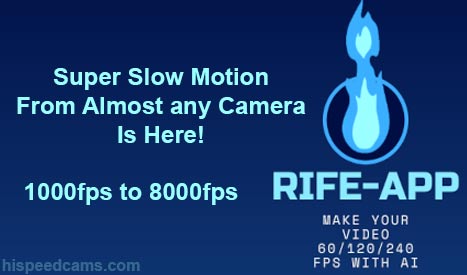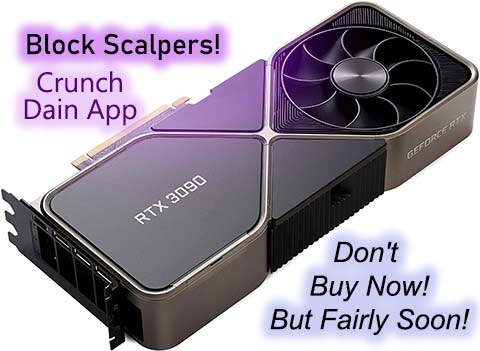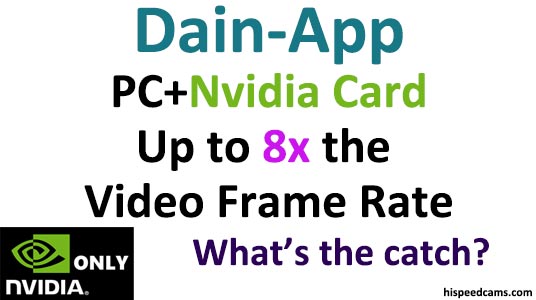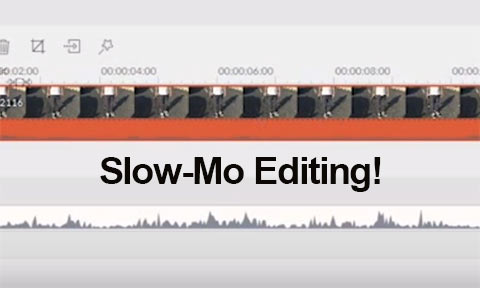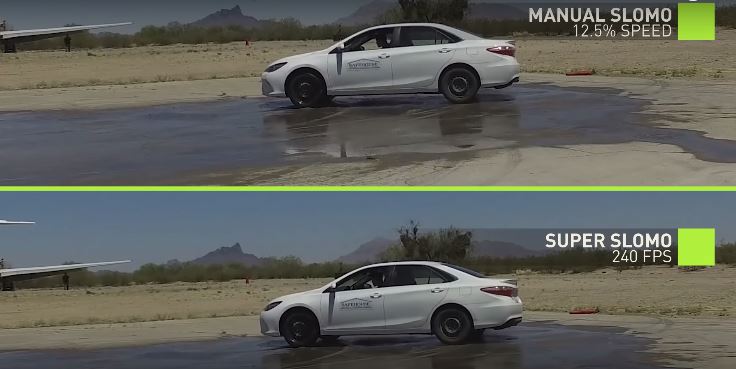Probably no computer-related technology has received more attention on the PC side than GPUs. NVidia launched the 3000 series of cards with aggressive pricing that completely obliterate the previous 2000 series GPUs for much less money. Things are great for PC gamers, machine learning coders, and 3D animators in 2020 with these levels of performance except for the fact that there is a complete scarcity of GPU cards in most lines including but not limited to the 2000 and 3000 series for a variety of reasons.
Dain app the machine learning frame rate interpolation software uses CUDA v5.0 as the minimum requirement or a GeForce GTX 750 as the minimum card to run it. But that does not mean it will be fast or be able to finish interpolating your high res footage. In fact, a 720p clip interpolated frame rate needs about 10-11GB of VRAM memory on the card as it runs the entirety of the calculation in video memory for predictive algorithms to work.
Dain app and the GPU Shortage:
Dain App will be able to run in any CUDA 5.0+ supported Nvidia card or the following:
- GeForce GTX 750 Ti, GeForce GTX 750, GeForce GTX 960M, GeForce GTX 950M, GeForce 940M, GeForce 930M, GeForce GTX 860M, GeForce GTX 850M, GeForce 845M, GeForce 840M, GeForce 830M, GeForce GTX 870M
- GeForce GTX Titan X, GeForce GTX 980 Ti, GeForce GTX 980, GeForce GTX 970, GeForce GTX 960, GeForce GTX 950, GeForce GTX 750 SE,
GeForce GTX 980M, GeForce GTX 970M, GeForce GTX 965M
- Nvidia TITAN Xp, Titan X,
GeForce GTX 1080 Ti, GTX 1080, GTX 1070 Ti, GTX 1070, GTX 1060,
GTX 1050 Ti, GTX 1050, GT 1030,
MX350, MX330, MX250, MX230, MX150, MX130, MX110
- NVIDIA TITAN RTX,
GeForce RTX 2080 Ti, RTX 2080 Super, RTX 2080, RTX 2070 Super, RTX 2070, RTX 2060 Super, RTX 2060,
GeForce GTX 1660 Ti, GTX 1660 Super, GTX 1660, GTX 1650 Super, GTX 1650, MX450
- GeForce RTX 3090, RTX 3080, RTX 3070, RTX 3060 Ti
However, since the app runs on video memory or VRAM you need a card with a minimum of 4GB of it to have any sort of success at interpolating frames. Even then your card will have too little VRAM to do anything over VGA resolution. There is a workaround however by using the Split frames into sections feature which will render small pixel buckets of frames and re-align a merged final frame with all the parts when done. This allows you to literally render up to 4k footage at higher frame rates without getting higher video memory.
How to Create Slow Motion Videos with DAIN APP | AI Frame Interpolation by GreenBox:
This workaround is very slow and can take days for a few second 4k clip to render on a mid-range PC. Your best bet is to get a faster GPU with tons of VRAM. In our view, a minimum of 10GB of VRAM or even better yet a minimum of 12GB is preferable to get the best performance. In Dain app your card’s CUDA cores are the primary speed accelerator but without enough VRAM it becomes slow as molasses.
The good news is that new Nvidia GPUs have more and more VRAM than ever before. The just-launched 3000 series toys with 24GB on the high end to 8GB on the low end 3060 Ti cards. However, none of these cards are available at this time at their suggested retail prices. Scalpers literally bought the entire free supply of cards and are selling them on eBay and Amazon at ridiculously high prices approaching anywhere from 40% to 150% mark up.
You would think that the 3060 Ti FE starting at $399 for an 8GB of VRAM card would be ideal for the Dain app, cheap, great performance, and close to the ideal 10GB of VRAM but there lies the problem. 8GB will force you to do segmented rendering for higher frame rates and that will limit your speed and video frame sizes. Your render time will increase exponentially with also some artifacts from conjoining segments showing up in some instances.
What to do?
If money is no object then we suggest you get a 3090 RTX card with 24GB of RAM. This will be the ideal card setup but we are talking at a hefty price increase as MSRP cards are nowhere to be found. Relying on scalpers will cost you dearly. You could still get a 3080 with 10GB of VRAM or a 3070, 3060 Ti with 8GB for about 40% more money.
There is a better option in our view and that is, wait for next year. Nvidia is going to ramp up production of 3000 series cards by Q1 2021 offering better lower-priced options of current cards and also a new 3060 card launching with less CUDA and Raytracing tensor cores but with a whopping 12GB of VRAM option.
By having 12GB of VRAM the 3060 card will be ideal for DAIN app on a budget and be able to render footage directly without segmenting the frames. You will get a big cut on CUDA cores on these cards compared to the 3060 TI. Rumors say that the 4864 CUDA cores of the 3060 Ti will drop down to 3840 on the regular 3060 card. That is a cut of 1000 cores. It will still have more CUDA cores than most of the 2000 series so it will still be a very capable card for sure. For example, a 2080 standard card only features 2944 CUDA Cores. You will really be able to get better technology for a smaller price tag for gaming, graphics, and machine learning applications like Dain app.
Card Options Today?
1. Nvidia RTX 3000 Series
We first start with the RTX 3000 series. You can get them today at high prices but the links below should adjust in time to much lower levels as supply catches up to demand.
amzn_assoc_placement = "adunit0";
amzn_assoc_tracking_id = "hispeedcams-20";
amzn_assoc_ad_mode = "manual";
amzn_assoc_ad_type = "smart";
amzn_assoc_marketplace = "amazon";
amzn_assoc_region = "US";
amzn_assoc_title = "RTX Cards at Amazon";
amzn_assoc_linkid = "21a8fc1df62beea447f50d845d979617";
amzn_assoc_rows = "4";
amzn_assoc_design = "text_links";
amzn_assoc_asins = "B08HBQWBHH,B08HR9D2JS,B08HRBW6VB,B08HR7SV3M,B08L8L71SM";
amzn_assoc_placement = "adunit0";
amzn_assoc_tracking_id = "hispeedcams-20";
amzn_assoc_ad_mode = "manual";
amzn_assoc_ad_type = "smart";
amzn_assoc_marketplace = "amazon";
amzn_assoc_region = "US";
amzn_assoc_title = "RTX 3060 Ti";
amzn_assoc_linkid = "92700d93b889e22be18ea83ae388dd07";
amzn_assoc_asins = "B08L8L71SM,B08PW559LL,B08QZ5GJ52,B08P3V572B";
amzn_assoc_rows = "4";
amzn_assoc_design = "text_links";
2. Nvidia RTX 2000 Series:
amzn_assoc_placement = "adunit0";
amzn_assoc_tracking_id = "hispeedcams-20";
amzn_assoc_ad_mode = "manual";
amzn_assoc_ad_type = "smart";
amzn_assoc_marketplace = "amazon";
amzn_assoc_region = "US";
amzn_assoc_title = "RTX 2000 Series!";
amzn_assoc_linkid = "edcfa31c5523b1f515240d3301577dbe";
amzn_assoc_rows = "4";
amzn_assoc_design = "text_links";
amzn_assoc_asins = "B07VR2GZMB,B08FYRG8XP,B07Y2R5Y2G,B07W3P4PC2";
amzn_assoc_placement = "adunit0";
amzn_assoc_tracking_id = "hispeedcams-20";
amzn_assoc_ad_mode = "manual";
amzn_assoc_ad_type = "smart";
amzn_assoc_marketplace = "amazon";
amzn_assoc_region = "US";
amzn_assoc_title = "RTX 2070 Series!";
amzn_assoc_linkid = "edcfa31c5523b1f515240d3301577dbe";
amzn_assoc_rows = "4";
amzn_assoc_design = "text_links";
amzn_assoc_asins = "B0856BVRFL,B07Y2R5Y2G,B07YXPVBWW,B07VDC5FDJ";
3. Get in the EVGA Queue!
The company EVGA has developed a product queue at https://www.evga.com/ that allows you to place your name on a waiting list and will email you the right to buy a card for 8 hours. If you do not buy it it will go to the next in line and you will have to re-register a new slot.
We feel this is great for two reasons, you get a great product at the MSRP price and you also refrain from supporting the scalping market. The downside is that you may have to wait weeks to months for a slot to become available.
4. Wait for next year!
If you wait until 2021, Nvidia will have a January announcement event for RTX with the rumored RTX 3060 card which will be the renamed 3050 ti card. There will be an option with 12GB of VRAM which will be the best in price performance and should be under $350 USD when it ships in quantity.
Final note:
We feel you should only buy a card now at inflated prices if you absolutely need it for mission-critical work. If you can wait please do so to combat price gouging and scalpers who destroy the legitimate market for technology parts.
We have rarely seen such a blatant attack to the consumer. The RTX cards have been gone in mere seconds from online sources due to bots that continuously scan for new stock and snatch it automatically. By not buying from them you support the community at large and save money in the process.
You can read our article on Dain App and the interpolation of footage that lets you create very convincing super slow motion from almost any frame rate. However, the app shines even more with high-speed footage. You can literally create a 4000fps video from a 1000fps source that looks almost as good as the real thing. Of course you will create frames and data from the ether so for mission-critical and lab studies, Dain app will not be an option.
If you get a new card and run it through Dain app, please share your results and footage below. Merry Christmas -HSC
amzn_assoc_placement = "adunit0";
amzn_assoc_tracking_id = "hispeedcams-20";
amzn_assoc_ad_mode = "manual";
amzn_assoc_ad_type = "smart";
amzn_assoc_marketplace = "amazon";
amzn_assoc_region = "US";
amzn_assoc_title = "RTX 3000 Series!";
amzn_assoc_linkid = "edcfa31c5523b1f515240d3301577dbe";
amzn_assoc_asins = "B08KWLMZV4,B08HR7SV3M,B08P2D3JSG,B08J5F3G18";
amzn_assoc_search_bar = "true";

